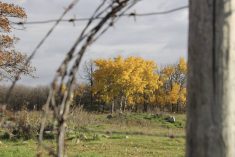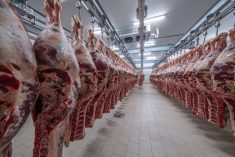Some producers in Manitoba and Saskatchewan are having to put cattle out to pasture earlier than they should because they don’t have enough feed supplies to nourish them.
“Feed is really expensive these days, so producers are not going to purchase more,” said Glenn Friesen, forage specialist with Manitoba Agriculture, Food and Rural Initiatives at Carman. “So, they’re going to get them out on pasture as fast as possible.”
The late spring, due to prolonged cold and wet weather in Western Canada has caused pastures to be ready later this year, and some producers in the eastern part of the prairies weren’t able to wait until the optimal time to put their cattle out to pasture.
Read Also

Ample supplies and improved livestock sector to boost Canadian feed sector: FCC
Abundant feed grain supplies and improved profitability for the livestock sector should support strong feed demand and sales through the winter, says a new report from Farm Credit Canada.
“It’s a bit of a perfect storm with short feed supplies and a late pasture,” said Friesen. “Producers are trying to find alternative ways to feed the animals or are dealing with the consequences of sending to pasture a little bit too soon.”
Friesen noted he’s also concerned about some fields being damaged because they’re still too wet for cattle to be out.
“The water is there underneath the surface, so it’s a little bit soft and spongy in areas,” he said. “We’re precautioning people to be a little bit careful about that.”
A handful of producers in Alberta faces similar problems, but not to the same extent as in Manitoba and Saskatchewan, said Ken Ziegler, beef and forage specialist with Alberta Agriculture and Rural Development at Rocky Mountain House.
“There are always those that are a little bit shy on feed, and then there is of course pressure to get them out sooner in the spring,” he said. “But, as a whole as an industry, we’re not as severe as the folks towards the east.”
Producers in Alberta who graze continuously on the same pasture all season are still waiting to put cattle out for the most part, while those who rotate between pastures already have them out.
Producers who continuously graze are still feeding hay to their cattle, he said, and they should have enough supplies to hold them until the next crop is harvested.
Producers in Saskatchewan and Manitoba are tighter on hay supplies, and are hoping for a good crop this year to replenish inventories.
Hay stands
New-crop hay production looks like it’s off to a good start across all three Prairie provinces, as large amounts of snowfall over the winter were beneficial.
Kevin France, provincial forage specialist with the Saskatchewan ministry of agriculture in Regina, said he hasn’t heard of any reports of winterkill damage yet this year.
Reports of winterkill in Alberta and Manitoba have been few and far between as well.
The large amounts of snowfall seen across the prairies this winter were also beneficial for soil moisture, which is benefiting forage and hay crops this spring.
The late spring may have some adverse affects on yields, but it will all depend on what happens during the summer growing season.
“It’s hard to tell now if the late spring is going to be a problem,” said Friesen. “One would think that that should reduce the yield but I’ve been around long enough to know that once the heat comes, the hay crops can catch up fairly quickly.”
— Terryn Shiells writes for Commodity News Service Canada, a Winnipeg company specializing in grain and commodity market reporting.















